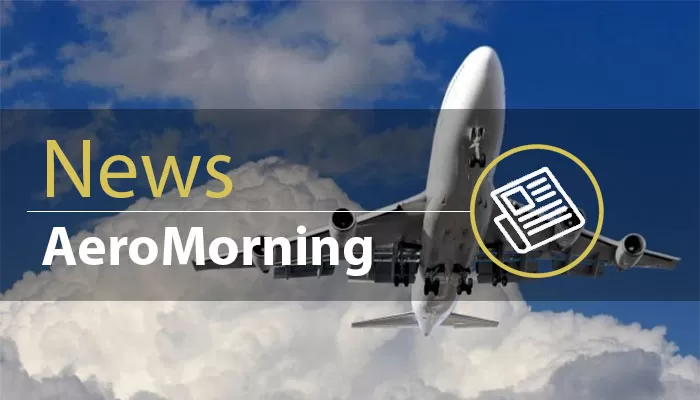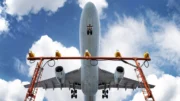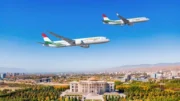by By AeroMorning on October 20, 2025
The aviation industry is facing an unprecedented challenge as a severe shortage of modern aircraft engines has forced airlines and leasing companies to dismantle nearly-new Airbus aircraft. The crisis, driven by supply chain disruptions and extended repair timelines, has left aviation experts warning of a ripple effect across global operations.
At Castellon Airport in eastern Spain, once a quiet regional hub, dozens of Airbus A321neo and other newer jets sit idle. Skilled technicians, dressed in protective gear, carefully remove engines and other valuable components from aircraft that are only a few years old. In many cases, the value of these engines now exceeds the resale value of the planes themselves, prompting owners to strip aircraft for spare parts.
The issue is particularly acute for engines produced by Pratt & Whitney, specifically the Geared TurboFan (GTF) models. Production delays and a rare metal defect discovered in 2023 have created a backlog in maintenance and inspections. Industry insiders report that hundreds of engines are awaiting service, with some fleets grounded or placed in long-term storage as airlines struggle to keep up with demand.
“I have never seen this scale of shortage before,” said Lee McConnellogue, CEO of eCube, a UK-based company specializing in dismantling and recycling aircraft. “We are able to recover nearly every component of a jet, from avionics to engines, making the aircraft effectively more valuable on the ground than in the air.”
Cirium data indicates that approximately one-third of the Airbus fleet equipped with GTF engines is currently immobilized, compared to only 4% for competitors using engines from CFM International. This disparity underscores the critical impact of the GTF shortage on airline operations and scheduling.
The situation has broader financial implications. Engines removed from aircraft can be leased as spare parts for approximately $200,000 per month each, a rate comparable to leasing the entire aircraft. Beyond engines, the other components of a dismantled Airbus can generate additional revenue, creating a financially viable, though operationally disruptive, strategy for owners.
Industry analysts point to the accelerated development of fuel-efficient engines in the early 2020s as a contributing factor. While these engines promised significant reductions in fuel consumption, the speed of production outpaced the available maintenance and support infrastructure, creating bottlenecks.
Airlines are also grappling with the operational consequences. Many carriers are forced to extend the service life of older jets to maintain capacity, while the shortage of new aircraft delays expansion plans and the replacement of aging fleets. “It’s a paradox,” said Austin Willis, CEO of Willis Lease. “Demand for modern jets is so high that one would expect airlines to keep them flying, yet the lack of engines is forcing them to take planes out of service entirely.”
Even financial stakeholders have taken notice. Private investors and leasing companies are increasingly investing in aircraft specifically for dismantling, betting that the parts market will yield higher returns than traditional leasing arrangements. Richard Brown, an aviation consultant at Naveo, described this as a growing niche within the commercial aviation ecosystem.
The International Air Transport Association (IATA) estimates that the shortage of engines and subsequent operational disruptions could cost airlines billions in lost revenue this year. Willie Walsh, IATA’s Director General, has warned that the industry faces more than $11 billion in additional costs due to supply chain and maintenance delays.
Pratt & Whitney acknowledges the backlog but notes that efforts are underway to resolve the bottlenecks, with gradual improvements expected over the next few years. Nonetheless, the shortage highlights a broader vulnerability in the commercial aircraft supply chain: the reliance on a small number of engine manufacturers and complex global logistics networks.
Airbus has not publicly commented on the dismantling of the aircraft at Castellon, but the company continues to face pressure to address delivery delays and support airlines affected by the engine shortage.
The unfolding situation offers a stark reminder that in aviation, technological advancements and operational efficiency must be balanced with robust maintenance and supply systems. As airlines navigate this challenging landscape, the industry may see further adjustments in fleet management strategies, including an increase in aircraft being retired or dismantled earlier than originally planned.
Conclusion
The engine shortage represents a critical stress point for the aviation sector, impacting airline operations, leasing strategies, and the global supply chain. While the recovery of valuable components provides a financial lifeline, the operational disruptions highlight vulnerabilities in an industry that has become increasingly reliant on just-in-time supply chains. The coming years will test how manufacturers, airlines, and service providers adapt to ensure that modern aircraft can continue flying efficiently and safely.
Source: Aéromorning










Be the first to comment on "Global Engine Shortages – mostly A320 Pratt & Whitney GTF – Force Nearly-New A320 Airbus Aircraft to Be Dismantled"